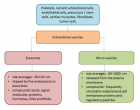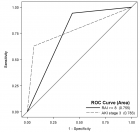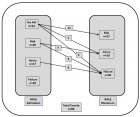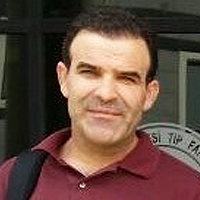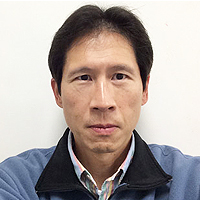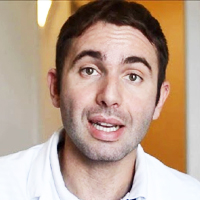Abstract
Review Article
Identification, characterization of candida species isolated from cases of vulvovaginal candidiasis along with their antifungal susceptibility by vitek-2 system
Atul R Rukadikar*, DK Mendiratta and Rafat Siddiqui
Published: 29 August, 2022 | Volume 6 - Issue 1 | Pages: 013-026
One of the most severe threats to world health is the Candida species. Many non-Candida species are the major cause of vulvovaginal candidiasis (VVC). During the development of VVC, the host environment and Candida vaginal colonization are assumed to be out of balance, and this might be owing to physiological or non-physiological changes. Host-related and behavioral risks have been connected to VVC. Novel antifungal medications with particular molecular targets may be developed with the use of molecular tools in epidemiological research and the study of resistant Candida species. Using the Vitek-2 Antifungal Susceptibility System, this review will explain the many approaches used to identify and characterize Candida species isolated from vulvovaginal candidiasis patients.
Read Full Article HTML DOI: 10.29328/journal.apcr.1001031 Cite this Article Read Full Article PDF
Keywords:
Antifungal; Candida; Susceptibility; Vulvovaginal candidiasis; Vitek- 2 system
References
- Sidrim JJ, Rocha MF. Medical mycology in the light of contemporary authors. Guanabara Koogan; 2004.
- Anaissie EJ, Anstead GM, Arias CA, Arora A, Baer SL, Bazan III C, Bradsher Jr RW, Chintapalli KN, Deresinski SC, Diekema DJ, Dignani MC. Clinical Mycology 2nd Ed [PDF] [tahir99] VRG. pdf.
- Ascioglu S, Rex JH, De Pauw B, Bennett JE, Bille J, Crokaert F, Denning DW, Donnelly JP, Edwards JE, Erjavec Z, Fiere D. Defining opportunistic invasive fungal infections in immunocompromised patients with cancer and hematopoietic stem cell transplants: an international consensus. Problems of Medical Mycology. 2003; 5(1):10-6.
- Beigi RH, Meyn LA, Moore DM, Krohn MA, Hillier SL. Vaginal yeast colonization in nonpregnant women: a longitudinal study. Obstet Gynecol. 2004 Nov;104(5 Pt 1):926-30. doi: 10.1097/01.AOG.0000140687.51048.73. PMID: 15516380.
- Ferrer J. Vaginal candidosis: epidemiological and etiological factors. Int J Gynaecol Obstet. 2000 Dec;71 Suppl 1:S21-7. doi: 10.1016/s0020-7292(00)00350-7. PMID: 11118561.
- Barker KS, Rogers PD. Recent insights into the mechanisms of antifungal resistance. Curr Infect Dis Rep. 2006 Nov;8(6):449-56. doi: 10.1007/s11908-006-0019-3. PMID: 17064638.
- Barbedo LS, Sgarbi DBG. Candidíase. J. Bras. Doenças Sex. Transm. 2010;22(1):22-38.
- Giolo MP, Svidzinski TIE. Pathophysiology, epidemiology and laboratory diagnosis of candidemia. J Bras Patol Med Lab. 2010;46(3):225- 234
- Yang YL. Virulence factors of Candida species. J Microbiol Immunol Infect. 2003;36(4):223-8
- Butler G. Fungal Sex and Pathogenesis. Clin. Microbiol. Rev. 2010;23(1):140-159.
- Colombo AL, Guimarães T. Epidemiologia das infecções hematogênicas por Candida spp [Epidemiology of hematogenous infections due to Candida spp]. Rev Soc Bras Med Trop. 2003 Sep-Oct;36(5):599-607. Portuguese. doi: 10.1590/s0037-86822003000500010. Epub 2003 Oct 21. PMID: 14576875.
- Gómez J, García-Vázquez E, Hernández A, Espinosa C, Ruiz J. Candidemias nosocomiales: nuevos retos de un problema emergente [Nosocomial candidemia: new challenges of an emergent problem]. Rev Esp Quimioter. 2010 Dec;23(4):158-68. Spanish. PMID: 21191553.
- Nguyen K, Zmeter G, Claris O, Kassai B. Epidemiology of invasive Candida infection in a neonatal intensive care unit in France. ActaPediat. 2012;101:137-139.
- Pfaller MA, Diekema DJ. Epidemiology of invasive candidiasis: a persistent public health problem. Clin Microbiol Rev. 2007 Jan;20(1):133-63. doi: 10.1128/CMR.00029-06. PMID: 17223626; PMCID: PMC1797637.
- Nucci M, Colombo AL. Candidemia due to Candida tropicalis: clinical, epidemiologic, and microbiologic characteristics of 188 episodes occurring in tertiary care hospitals. Diagn Microbiol Infect Dis. 2007 May;58(1):77-82. doi: 10.1016/j.diagmicrobio.2006.11.009. Epub 2007 Mar 26. PMID: 17368800.
- Sipsas NV, Lewis RE, Tarrand J, Hachem R, Rolston KV, Raad II, Kontoyiannis DP. Candidemia in patients with hematologic malignancies in the era of new antifungal agents (2001-2007): stable incidence but changing epidemiology of a still frequently lethal infection. Cancer. 2009 Oct 15;115(20):4745-52. doi: 10.1002/cncr.24507. PMID: 19634156.
- Godoy P, Tiraboschi IN, Severo LC, Bustamante B, Calvo B, Almeida LP, da Matta DA, Colombo AL. Species distribution and antifungal susceptibility profile of Candida spp. bloodstream isolates from Latin American hospitals. Mem Inst Oswaldo Cruz. 2003 Apr;98(3):401-5. doi: 10.1590/s0074-02762003000300020. Epub 2003 Jul 18. PMID: 12886424.
- Almeida AA, Mesquita CS, Svidzinski TI, Oliveira KM. Antifungal susceptibility and distribution of Candida spp. isolates from the University Hospital in the municipality of Dourados, State of Mato Grosso do Sul, Brazil. Rev Soc Bras Med Trop. 2013 May-Jun;46(3):335-9. doi: 10.1590/0037-8682-0074-2012. PMID: 23856873.
- Goldman M, Pottage Júnior JC, Weaver DC. Candida kruseifungemia. Report of 4 cases and review of the literature. Medicine [Baltimore]. 1993;72(3):143-150.
- TrofaD, Gácser A, Nosanchuk JD. Candida parapsilosis, an emerging fungal pathogen. Clin. Microbiol. Ver. 2008; 21(4):606-625.
- Brito LR, Guimarães T, Nucci M, Rosas RC, Paula Almeida L, Da Matta DA, Colombo AL. Clinical and microbiological aspects of candidemia due to Candida parapsilosis in Brazilian tertiary care hospitals. Med Mycol. 2006 May;44(3):261-6. doi: 10.1080/13693780500421476. PMID: 16702106.
- van Asbeck EC, Huang YC, Markham AN, Clemons KV, Stevens DA. Candida parapsilosis fungemia in neonates: genotyping results suggest healthcare workers hands as source, and review of published studies. Mycopathologia. 2007 Dec;164(6):287-93. doi: 10.1007/s11046-007-9054-3. Epub 2007 Sep 15. PMID: 17874281.
- Spolidorio DMP, Boriollo MFG, Carlos Estrela C, Spolidorio LC. Diferentes métodos fenotípicos para isolamento e identificação de espécies deCandida. Robrac. 2009;18(45):18-26.
- Higashi CM, Takashina FH, Rechenchoski ZD3, Stipp-Abe AT, Vespero EC, Quesada RMB, et al. Comparison of the Vitek 2 automated identification system and PCR-ITS for species characterization of clinical isolates of Candidaspp. Biological and Health Sciences. 2015; 36(1):233-242.
- Meletiadis J, Arabatzis M, Bompola M, Tsiveriotis K, Hini S, Petinaki E, Velegraki A, Zerva L. Comparative evaluation of three commercial identification systems using common and rare bloodstream yeast isolates. J Clin Microbiol. 2011 Jul;49(7):2722-7. doi: 10.1128/JCM.01253-10. Epub 2011 May 4. PMID: 21543578; PMCID: PMC3147866.
- Kumar S, Vyas A, Kumar M, Mehra SK. Application of CHROMagarCandida for identification of clinically important Candida species and their antifungal susceptibility pattern. IJBMR. 2013;4(4):3600-3606.
- Tamura NK, Negri MF, Bonassoli LA, Svidzinski TI. Fatores de virulência de Candida spp isoladas de cateteres venosos e mãos de servidores hospitalares [Virulence factors for Candida spp recovered from intravascular catheters and hospital workers hands]. Rev Soc Bras Med Trop. 2007 Jan-Feb;40(1):91-3. Portuguese. doi: 10.1590/s0037-86822007000100021. PMID: 17486265.
- Silva S, Negri M, Henriques M, Oliveira R, Williams DW, Azeredo J. Candida glabrata, Candida parapsilosis and Candida tropicalis: biology, epidemiology, pathogenicity and antifungal resistance. FEMS Microbiol Rev. 2012 Mar;36(2):288-305. doi: 10.1111/j.1574-6976.2011.00278.x. Epub 2011 Jun 6. PMID: 21569057.
- Ahmed A, Bashir M. Association of infection among intrauterine contraceptive device users in family planning clinics in Sudan.
- Verstrepen KJ, Klis FM. Flocculation, adhesion and biofilm formation in yeasts. Mol Microbiol. 2006 Apr;60(1):5-15. doi: 10.1111/j.1365-2958.2006.05072.x. PMID: 16556216.
- Chaffin WL. Candida albicans cell wall proteins. Microbiol Mol Biol Rev. 2008 Sep;72(3):495-544. doi: 10.1128/MMBR.00032-07. PMID: 18772287; PMCID: PMC2546859.
- Cheng G, Wozniak K, Wallig MA, Fidel PL Jr, Trupin SR, Hoyer LL. Comparison between Candida albicans agglutinin-like sequence gene expression patterns in human clinical specimens and models of vaginal candidiasis. Infect Immun. 2005 Mar;73(3):1656-63. doi: 10.1128/IAI.73.3.1656-1663.2005. PMID: 15731066; PMCID: PMC1064955.
- Butler G, Rasmussen MD, Lin MF, Santos MA, Sakthikumar S, Munro CA, Rheinbay E, Grabherr M, Forche A, Reedy JL, Agrafioti I, Arnaud MB, Bates S, Brown AJ, Brunke S, Costanzo MC, Fitzpatrick DA, de Groot PW, Harris D, Hoyer LL, Hube B, Klis FM, Kodira C, Lennard N, Logue ME, Martin R, Neiman AM, Nikolaou E, Quail MA, Quinn J, Santos MC, Schmitzberger FF, Sherlock G, Shah P, Silverstein KA, Skrzypek MS, Soll D, Staggs R, Stansfield I, Stumpf MP, Sudbery PE, Srikantha T, Zeng Q, Berman J, Berriman M, Heitman J, Gow NA, Lorenz MC, Birren BW, Kellis M, Cuomo CA. Evolution of pathogenicity and sexual reproduction in eight Candida genomes. Nature. 2009 Jun 4;459(7247):657-62. doi: 10.1038/nature08064. PMID: 19465905; PMCID: PMC2834264.
- Douglas LJ. Candida biofilms and their role in infection. Trends Microbiol. 2003 Jan;11(1):30-6. doi: 10.1016/s0966-842x(02)00002-1. PMID: 12526852.
- Donlan RM. Biofilms: microbial life on surfaces. Emerg Infect Dis. 2002 Sep;8(9):881-90. doi: 10.3201/eid0809.020063. PMID: 12194761; PMCID: PMC2732559.
- Ramage G, Rajendran R, Sherry L, Williams C. Fungal biofilm resistance. Int J Microbiol. 2012;2012:528521. doi: 10.1155/2012/528521. Epub 2012 Feb 8. PMID: 22518145; PMCID: PMC3299327.
- Silva S, Henriques M, Martins A, Oliveira R, Williams D, Azeredo J. Biofilms of non-Candida albicans Candida species: quantification, structure and matrix composition. Med Mycol. 2009 Nov;47(7):681-9. doi: 10.3109/13693780802549594. PMID: 19888800.
- Harriott MM, Lilly EA, Rodriguez TE, Fidel PL, Noverr MC. Candida albicans forms biofilms on the vaginal mucosa. Microbiology (Reading). 2010 Dec;156(Pt 12):3635-3644. doi: 10.1099/mic.0.039354-0. Epub 2010 Aug 12. PMID: 20705667; PMCID: PMC3068702.
- Rivers CA, Adaramola OO, Schwebke JR. Prevalence of bacterial vaginosis and vulvovaginal candidiasis mixed infection in a southeastern american STD clinic. Sex Transm Dis. 2011 Jul;38(7):672-4. doi: 10.1097/OLQ.0b013e31820fc3b8. PMID: 21844715.
- Schaller M, Borelli C, Korting HC, Hube B. Hydrolytic enzymes as virulence factors of Candida albicans. Mycoses. 2005 Nov;48(6):365-77. doi: 10.1111/j.1439-0507.2005.01165.x. PMID: 16262871.
- Mohandas V, Ballal M. Distribution of Candida species in different clinical samples and their virulence: biofilm formation, proteinase and phospholipase production: a study on hospitalized patients in southern India. J Glob Infect Dis. 2011 Jan;3(1):4-8. doi: 10.4103/0974-777X.77288. PMID: 21572601; PMCID: PMC3068577.
- Alves CT, Wei XQ, Silva S, Azeredo J, Henriques M, Williams DW. Candida albicans promotes invasion and colonisation of Candida glabrata in a reconstituted human vaginal epithelium. J Infect. 2014 Oct;69(4):396-407. doi: 10.1016/j.jinf.2014.06.002. Epub 2014 Jun 9. PMID: 24924556.
- Zarrinfar H, Kaboli S, Dolatabadi S, Mohammadi R. Rapid detection of Candida species in bronchoalveolar lavage fluid from patients with pulmonary symptoms. Braz J Microbiol. 2016 Jan-Mar;47(1):172-6. doi: 10.1016/j.bjm.2015.02.001. Epub 2016 Jan 27. PMID: 26887241; PMCID: PMC4822774.
- Zordan RE, Miller MG, Galgoczy DJ, Tuch BB, Johnson AD. Interlocking transcriptional feedback loops control white-opaque switching in Candida albicans. PLoS Biol. 2007 Oct;5(10):e256. doi: 10.1371/journal.pbio.0050256. PMID: 17880264; PMCID: PMC1976629.
- Brockert PJ, Lachke SA, Srikantha T, Pujol C, Galask R, Soll DR. Phenotypic switching and mating type switching of Candida glabrata at sites of colonization. Infect Immun. 2003 Dec;71(12):7109-18. doi: 10.1128/IAI.71.12.7109-7118.2003. PMID: 14638801; PMCID: PMC308932.
- Braun BR, van Het Hoog M, d'Enfert C, Martchenko M, Dungan J, Kuo A, Inglis DO, Uhl MA, Hogues H, Berriman M, Lorenz M, Levitin A, Oberholzer U, Bachewich C, Harcus D, Marcil A, Dignard D, Iouk T, Zito R, Frangeul L, Tekaia F, Rutherford K, Wang E, Munro CA, Bates S, Gow NA, Hoyer LL, Köhler G, Morschhäuser J, Newport G, Znaidi S, Raymond M, Turcotte B, Sherlock G, Costanzo M, Ihmels J, Berman J, Sanglard D, Agabian N, Mitchell AP, Johnson AD, Whiteway M, Nantel A. A human-curated annotation of the Candida albicans genome. PLoS Genet. 2005 Jul;1(1):36-57. doi: 10.1371/journal.pgen.0010001. Epub 2005 Jun 17. PMID: 16103911; PMCID: PMC1183520.
- Jones T, Federspiel NA, Chibana H, Dungan J, Kalman S, Magee BB, Newport G, Thorstenson YR, Agabian N, Magee PT, Davis RW, Scherer S. The diploid genome sequence of Candida albicans. Proc Natl Acad Sci U S A. 2004 May 11;101(19):7329-34. doi: 10.1073/pnas.0401648101. Epub 2004 May 3. PMID: 15123810; PMCID: PMC409918.
- Butler G, Rasmussen MD, Lin MF, Santos MA, Sakthikumar S, Munro CA, Rheinbay E, Grabherr M, Forche A, Reedy JL, Agrafioti I, Arnaud MB, Bates S, Brown AJ, Brunke S, Costanzo MC, Fitzpatrick DA, de Groot PW, Harris D, Hoyer LL, Hube B, Klis FM, Kodira C, Lennard N, Logue ME, Martin R, Neiman AM, Nikolaou E, Quail MA, Quinn J, Santos MC, Schmitzberger FF, Sherlock G, Shah P, Silverstein KA, Skrzypek MS, Soll D, Staggs R, Stansfield I, Stumpf MP, Sudbery PE, Srikantha T, Zeng Q, Berman J, Berriman M, Heitman J, Gow NA, Lorenz MC, Birren BW, Kellis M, Cuomo CA. Evolution of pathogenicity and sexual reproduction in eight Candida genomes. Nature. 2009 Jun 4;459(7247):657-62. doi: 10.1038/nature08064. PMID: 19465905; PMCID: PMC2834264.
- Dujon B, Sherman D, Fischer G, Durrens P, Casaregola S, Lafontaine I, De Montigny J, Marck C, Neuvéglise C, Talla E, Goffard N, Frangeul L, Aigle M, Anthouard V, Babour A, Barbe V, Barnay S, Blanchin S, Beckerich JM, Beyne E, Bleykasten C, Boisramé A, Boyer J, Cattolico L, Confanioleri F, De Daruvar A, Despons L, Fabre E, Fairhead C, Ferry-Dumazet H, Groppi A, Hantraye F, Hennequin C, Jauniaux N, Joyet P, Kachouri R, Kerrest A, Koszul R, Lemaire M, Lesur I, Ma L, Muller H, Nicaud JM, Nikolski M, Oztas S, Ozier-Kalogeropoulos O, Pellenz S, Potier S, Richard GF, Straub ML, Suleau A, Swennen D, Tekaia F, Wésolowski-Louvel M, Westhof E, Wirth B, Zeniou-Meyer M, Zivanovic I, Bolotin-Fukuhara M, Thierry A, Bouchier C, Caudron B, Scarpelli C, Gaillardin C, Weissenbach J, Wincker P, Souciet JL. Genome evolution in yeasts. Nature. 2004 Jul 1;430(6995):35-44. doi: 10.1038/nature02579. PMID: 15229592.
- Bridge PD, Spooner BM, Roberts PJ. The impact of molecular data in fungal systematics. InAdvances in botanical research. Academic Press; 2005; 42: 33-67).
- Hebert PD, Cywinska A, Ball SL, deWaard JR. Biological identifications through DNA barcodes. Proc Biol Sci. 2003 Feb 7;270(1512):313-21. doi: 10.1098/rspb.2002.2218. PMID: 12614582; PMCID: PMC1691236.
- Schindel DE, Miller SE. DNA barcoding a useful tool for taxonomists. Nature. 2005 May 5;435(7038):17. doi: 10.1038/435017b. PMID: 15874991.
- Seifert KA, Samson RA, Dewaard JR, Houbraken J, Lévesque CA, Moncalvo JM, Louis-Seize G, Hebert PD. Prospects for fungus identification using CO1 DNA barcodes, with Penicillium as a test case. Proc Natl Acad Sci U S A. 2007 Mar 6;104(10):3901-6. doi: 10.1073/pnas.0611691104. Epub 2007 Feb 28. PMID: 17360450; PMCID: PMC1805696.
- Dentinger BT, Didukh MY, Moncalvo JM. Comparing COI and ITS as DNA barcode markers for mushrooms and allies (Agaricomycotina). PLoS One. 2011;6(9):e25081. doi: 10.1371/journal.pone.0025081. Epub 2011 Sep 22. PMID: 21966418; PMCID: PMC3178597.
- Simon L, BousquetJ, Levesque RC, Lalonde M. Origin and diversification of endomycorrhizal fungi and coincidence with vascular land plants. Nature. 1993;363:67-69.
- Shokohi T, Hashemi Soteh MB, Saltanat Pouri Z, Hedayati MT, Mayahi S. Identification of Candida species using PCR-RFLP in cancer patients in Iran. Indian J Med Microbiol. 2010 Apr-Jun;28(2):147-51. doi: 10.4103/0255-0857.62493. PMID: 20404462.
- Schoch CL, Seifert KA, Huhndorf S, Robert V, Spouge JL, Levesque CA, Chen W; Fungal Barcoding Consortium; Fungal Barcoding Consortium Author List. Nuclear ribosomal internal transcribed spacer (ITS) region as a universal DNA barcode marker for Fungi. Proc Natl Acad Sci U S A. 2012 Apr 17;109(16):6241-6. doi: 10.1073/pnas.1117018109. Epub 2012 Mar 27. PMID: 22454494; PMCID: PMC3341068.
- Kurtzman CP, Albertyn J, Basehoar-Powers E. Multigene phylogenetic analysis of the Lipomycetaceae and the proposed transfer of Zygozyma species to Lipomyces and Babjevia anomala to Dipodascopsis. FEMS Yeast Res. 2007 Sep;7(6):1027-34. doi: 10.1111/j.1567-1364.2007.00246.x. Epub 2007 May 10. PMID: 17498213.
- Brinkman FS, Leipe DD. Phylogenetic analysis. Methods Biochem Anal. 2001;43:323-58. doi: 10.1002/0471223921.ch14. PMID: 11449731.
- Cummings CA, Relman DA. Using DNA microarrays to study host-microbe interactions. Emerg Infect Dis. 2000 Sep-Oct;6(5):513-25. doi: 10.3201/eid0605.000511. PMID: 10998383; PMCID: PMC2627958.
- Maiden MC, Bygraves JA, Feil E, Morelli G, Russell JE, Urwin R, Zhang Q, Zhou J, Zurth K, Caugant DA, Feavers IM, Achtman M, Spratt BG. Multilocus sequence typing: a portable approach to the identification of clones within populations of pathogenic microorganisms. Proc Natl Acad Sci U S A. 1998 Mar 17;95(6):3140-5. doi: 10.1073/pnas.95.6.3140. PMID: 9501229; PMCID: PMC19708.
- Odds FC, Jacobsen MD. Multilocus sequence typing of pathogenic Candida species. Eukaryot Cell. 2008 Jul;7(7):1075-84. doi: 10.1128/EC.00062-08. Epub 2008 May 2. PMID: 18456859; PMCID: PMC2446668.
- Bougnoux ME, Morand S, d'Enfert C. Usefulness of multilocus sequence typing for characterization of clinical isolates of Candida albicans. J Clin Microbiol. 2002 Apr;40(4):1290-7. doi: 10.1128/JCM.40.4.1290-1297.2002. PMID: 11923347; PMCID: PMC140389.
- Tavanti A, Gow NA, Senesi S, Maiden MC, Odds FC. Optimization and validation of multilocus sequence typing for Candida albicans. J Clin Microbiol. 2003 Aug;41(8):3765-76. doi: 10.1128/JCM.41.8.3765-3776.2003. PMID: 12904388; PMCID: PMC179823.
- Bougnoux ME, Tavanti A, Bouchier C, Gow NA, Magnier A, Davidson AD, Maiden MC, D'Enfert C, Odds FC. Collaborative consensus for optimized multilocus sequence typing of Candida albicans. J Clin Microbiol. 2003 Nov;41(11):5265-6. doi: 10.1128/JCM.41.11.5265-5266.2003. PMID: 14605179; PMCID: PMC262540.
- Arnaud MB, Costanzo MC, Skrzypek MS, Shah P, Binkley G, Lane C, Miyasato SR, Sherlock G. Sequence resources at the Candida Genome Database. Nucleic Acids Res. 2007 Jan;35(Database issue):D452-6. doi: 10.1093/nar/gkl899. Epub 2006 Nov 7. PMID: 17090582; PMCID: PMC1669745.
- Tavanti A, Davidson AD, Fordyce MJ, Gow NA, Maiden MC, Odds FC. Population structure and properties of Candida albicans, as determined by multilocus sequence typing. J Clin Microbiol. 2005 Nov;43(11):5601-13. doi: 10.1128/JCM.43.11.5601-5613.2005. PMID: 16272493; PMCID: PMC1287804.
- Odds FC, Bougnoux ME, Shaw DJ, Bain JM, Davidson AD, Diogo D, Jacobsen MD, Lecomte M, Li SY, Tavanti A, Maiden MC, Gow NA, d'Enfert C. Molecular phylogenetics of Candida albicans. Eukaryot Cell. 2007 Jun;6(6):1041-52. doi: 10.1128/EC.00041-07. Epub 2007 Apr 6. PMID: 17416899; PMCID: PMC1951527.
- Wang H, Guo H, Sun S, Xu J. Abundant sequence variation around the mitochondrial origin of replication in the human opportunistic yeast pathogen Candida albicans from a tropical island in China. Fungal Genet Biol. 2007 Oct;44(10):991-1001. doi: 10.1016/j.fgb.2007.03.005. Epub 2007 Apr 2. PMID: 17493848.
- Ge SH, Wan Z, Li J, Xu J, Li RY, Bai FY. Correlation between azole susceptibilities, genotypes, and ERG11 mutations in Candida albicans isolates associated with vulvovaginal candidiasis in China. Antimicrob Agents Chemother. 2010 Aug;54(8):3126-31. doi: 10.1128/AAC.00118-10. Epub 2010 Jun 1. PMID: 20516286; PMCID: PMC2916359.
- Dodgson AR, Pujol C, Denning DW, Soll DR, Fox AJ. Multilocus sequence typing of Candida glabrata reveals geographically enriched clades. J Clin Microbiol. 2003 Dec;41(12):5709-17. doi: 10.1128/JCM.41.12.5709-5717.2003. PMID: 14662965; PMCID: PMC309006.
- Lott TJ, Frade JP, Lockhart SR. Multilocus sequence type analysis reveals both clonality and recombination in populations of Candida glabrata bloodstream isolates from U.S. surveillance studies. Eukaryot Cell. 2010 Apr;9(4):619-25. doi: 10.1128/EC.00002-10. Epub 2010 Feb 26. PMID: 20190071; PMCID: PMC2863408.
- Tavanti A, Davidson AD, Johnson EM, Maiden MC, Shaw DJ, Gow NA, Odds FC. Multilocus sequence typing for differentiation of strains of Candida tropicalis. J Clin Microbiol. 2005 Nov;43(11):5593-600. doi: 10.1128/JCM.43.11.5593-5600.2005. PMID: 16272492; PMCID: PMC1287820.
- Jacobsen MD, Rattray AM, Gow NA, Odds FC, Shaw DJ. Mitochondrial haplotypes and recombination in Candida albicans. Med Mycol. 2008 Nov;46(7):647-54. doi: 10.1080/13693780801986631. PMID: 18608923.
- Magri MM, Gomes-Gouvêa MS, de Freitas VL, Motta AL, Moretti ML, Shikanai-Yasuda MA. Multilocus sequence typing of Candida tropicalis shows the presence of different clonal clusters and fluconazole susceptibility profiles in sequential isolates from candidemia patients in Sao Paulo, Brazil. J Clin Microbiol. 2013 Jan;51(1):268-77. doi: 10.1128/JCM.02366-12. Epub 2012 Nov 14. PMID: 23152555; PMCID: PMC3536249.
- Garnaud C, Botterel F, Sertour N, Bougnoux ME, Dannaoui E, Larrat S, Hennequin C, Guinea J, Cornet M, Maubon D. Next-generation sequencing offers new insights into the resistance of Candida spp. to echinocandins and azoles. J Antimicrob Chemother. 2015 Sep;70(9):2556-65. doi: 10.1093/jac/dkv139. Epub 2015 May 27. PMID: 26017039.
- dos Santos Silva DB, de Oliveira KM, Grisolia AB. Molecular Methods Developed for the Identification and Characterization of Candida Species.
- Awari A. Species distribution and antifungal susceptibility profile of Candida isolated from urine samples. Int J App Basic Med Res. 2011; 18:228-34.
- Pappas PG, Kauffman CA, Andes D, Benjamin DK Jr, Calandra TF, Edwards JE Jr, Filler SG, Fisher JF, Kullberg BJ, Ostrosky-Zeichner L, Reboli AC, Rex JH, Walsh TJ, Sobel JD; Infectious Diseases Society of America. Clinical practice guidelines for the management of candidiasis: 2009 update by the Infectious Diseases Society of America. Clin Infect Dis. 2009 Mar 1;48(5):503-35. doi: 10.1086/596757. PMID: 19191635; PMCID: PMC7294538.
- Sobel JD. Genital candidiasis. Medicine. 2005 Oct 1;33(10):62-5.
- Nwadioha SI, Egah DZ, Alao OO, Iheanacho E. Risk factors for vaginal candidiasis among women attending primary health care centers of Jos, Nigeria. J Clin Med Res. 2010 Jul 31;2(7):110-3.
- Amouri I, Sellami H, Borji N, Abbes S, Sellami A, Cheikhrouhou F, Maazoun L, Khaled S, Khrouf S, Boujelben Y, Ayadi A. Epidemiological survey of vulvovaginal candidosis in Sfax, Tunisia. Mycoses. 2011 Sep;54(5):e499-505. doi: 10.1111/j.1439-0507.2010.01965.x. Epub 2010 Oct 29. PMID: 21039942.
- Mahmoudi Rad M, Zafarghandi S, Abbasabadi B, Tavallaee M. The epidemiology of Candida species associated with vulvovaginal candidiasis in an Iranian patient population. Eur J Obstet Gynecol Reprod Biol. 2011 Apr;155(2):199-203. doi: 10.1016/j.ejogrb.2010.11.022. Epub 2010 Dec 30. PMID: 21194828.
- Linhares LM, Witkin SS, Miranda SD, Fonseca AM, Pinotti JA, Ledger WJ. Differentiation between women with vulvovaginal symptoms who are positive or negative for Candida species by culture. Infect Dis Obstet Gynecol. 2001;9(4):221-5. doi: 10.1155/S1064744901000369. PMID: 11916179; PMCID: PMC1784657.
- Grigoriou O, Baka S, Makrakis E, Hassiakos D, Kapparos G, Kouskouni E. Prevalence of clinical vaginal candidiasis in a university hospital and possible risk factors. Eur J Obstet Gynecol Reprod Biol. 2006 May 1;126(1):121-5. doi: 10.1016/j.ejogrb.2005.09.015. Epub 2005 Oct 26. PMID: 16256258.
- Fan SR, Liao QP, Liu XP, Liu ZH, Zhang D. Vaginal allergic response in women with vulvovaginal candidiasis. Int J Gynaecol Obstet. 2008 Apr;101(1):27-30. doi: 10.1016/j.ijgo.2007.08.024. Epub 2008 Feb 15. PMID: 18280478.
- Goswami D, Goswami R, Banerjee U, Dadhwal V, Miglani S, Lattif AA, Kochupillai N. Pattern of Candida species isolated from patients with diabetes mellitus and vulvovaginal candidiasis and their response to single dose oral fluconazole therapy. J Infect. 2006 Feb;52(2):111-7. doi: 10.1016/j.jinf.2005.03.005. PMID: 15908007.
- Richter SS, Galask RP, Messer SA, Hollis RJ, Diekema DJ, Pfaller MA. Antifungal susceptibilities of Candida species causing vulvovaginitis and epidemiology of recurrent cases. J Clin Microbiol. 2005 May;43(5):2155-62. doi: 10.1128/JCM.43.5.2155-2162.2005. PMID: 15872235; PMCID: PMC1153777.
- Sobel JD, Chaim W, Nagappan V, Leaman D. Treatment of vaginitis caused by Candida glabrata: use of topical boric acid and flucytosine. Am J Obstet Gynecol. 2003 Nov;189(5):1297-300. doi: 10.1067/s0002-9378(03)00726-9. PMID: 14634557.
- Safdar A, Armstrong D, Cross EW, Perlin DS. Prospective epidemiologic analysis of triazole-resistant nosocomial Candida glabrata isolated from patients at a comprehensive cancer center. Int J Infect Dis. 2002 Sep;6(3):198-201. doi: 10.1016/s1201-9712(02)90111-6. PMID: 12718835.
- Patel DA, Gillespie B, Sobel JD, Leaman D, Nyirjesy P, Weitz MV, Foxman B. Risk factors for recurrent vulvovaginal candidiasis in women receiving maintenance antifungal therapy: results of a prospective cohort study. Am J Obstet Gynecol. 2004 Mar;190(3):644-53. doi: 10.1016/j.ajog.2003.11.027. PMID: 15041994.
- M27-a3, Reference Method for Broth dilution antifungal susceptibility testing of yeasts; approved standard - third Edition 2008, clinical and laboratory standards Institute, Wayne, usa
- Subcommittee on Antifungal Susceptibility Testing (AFST) of the ESCMID European Committee for Antimicrobial Susceptibility Testing (EUCAST). EUCAST definitive document EDef 7.1: method for the determination of broth dilution MICs of antifungal agents for fermentative yeasts. Clin Microbiol Infect. 2008 Apr;14(4):398-405. doi: 10.1111/j.1469-0691.2007.01935.x. Epub 2008 Jan 11. Erratum in: Clin Microbiol Infect. 2009 Jan;15(1):103. PMID: 18190574.
- Cuenca-Estrella M, Lee-Yang W, Ciblak MA, Arthington-Skaggs BA, Mellado E, Warnock DW, Rodriguez-Tudela JL. Comparative evaluation of NCCLS M27-A and EUCAST broth microdilution procedures for antifungal susceptibility testing of candida species. Antimicrob Agents Chemother. 2002 Nov;46(11):3644-7. doi: 10.1128/AAC.46.11.3644-3647.2002. PMID: 12384382; PMCID: PMC128746.
- Pfaller MA, Castanheira M, Diekema DJ, Messer SA, Moet GJ, Jones RN. Comparison of European Committee on Antimicrobial Susceptibility Testing (EUCAST) and Etest methods with the CLSI broth microdilution method for echinocandin susceptibility testing of Candida species. J Clin Microbiol. 2010 May;48(5):1592-9. doi: 10.1128/JCM.02445-09. Epub 2010 Mar 24. PMID: 20335424; PMCID: PMC2863935.
- Arendrup MC. Candida and candidaemia. Susceptibility and epidemiology. Dan Med J. 2013 Nov;60(11):B4698. PMID: 24192246.
- Cuenca-Estrella M, Gomez-Lopez A, Alastruey-Izquierdo A, Bernal-Martinez L, Cuesta I, Buitrago MJ, Rodriguez-Tudela JL. Comparison of the Vitek 2 antifungal susceptibility system with the clinical and laboratory standards institute (CLSI) and European Committee on Antimicrobial Susceptibility Testing (EUCAST) Broth Microdilution Reference Methods and with the Sensititre YeastOne and Etest techniques for in vitro detection of antifungal resistance in yeast isolates. J Clin Microbiol. 2010 May;48(5):1782-6. doi: 10.1128/JCM.02316-09. Epub 2010 Mar 10. PMID: 20220169; PMCID: PMC2863906.
- Arendrup MC, Kahlmeter G, Rodriguez-Tudela JL, Donnelly JP. Breakpoints for susceptibility testing should not divide wild-type distributions of important target species. Antimicrob Agents Chemother. 2009 Apr;53(4):1628-9. doi: 10.1128/AAC.01624-08. Epub 2009 Feb 2. PMID: 19188378; PMCID: PMC2663114.
- Schmalreck AF, Willinger B, Haase G, Blum G, Lass-Flörl C, Fegeler W, Becker K; Antifungal Susceptibility Testing-AFST Study Group. Species and susceptibility distribution of 1062 clinical yeast isolates to azoles, echinocandins, flucytosine and amphotericin B from a multi-centre study. Mycoses. 2012 May;55(3):e124-37. doi: 10.1111/j.1439-0507.2011.02165.x. Epub 2012 Jan 11. PMID: 22233267.
- Zhang L, Zhou S, Pan A, Li J, Liu B. Surveillance of antifungal susceptibilities in clinical isolates of Candida species at 36 hospitals in China from 2009 to 2013. Int J Infect Dis. 2015 Apr;33:1-4. doi: 10.1016/j.ijid.2014.12.033. Epub 2014 Dec 23. PMID: 25541294.
- Pfaller MA, Rhomberg PR, Messer SA, Castanheira M. In vitro activity of a Hos2 deacetylase inhibitor, MGCD290, in combination with echinocandins against echinocandin-resistant Candida species. Diagn Microbiol Infect Dis. 2015 Apr;81(4):259-63. doi: 10.1016/j.diagmicrobio.2014.11.008. Epub 2014 Nov 25. PMID: 25600842.
- Nieto MC, Tellería O, Cisterna R. Sentinel surveillance of invasive candidiasis in Spain: epidemiology and antifungal susceptibility. Diagn Microbiol Infect Dis. 2015 Jan;81(1):34-40. doi: 10.1016/j.diagmicrobio.2014.05.021. Epub 2014 Jun 5. PMID: 25439581.
- Wanjare S, Gupta R, Mehta P. Caspofungin MIC Distribution amongst Commonly Isolated CandidaSpecies in a Tertiary Care Centre - An Indian Experience. J Clin Diagn Res. 2016 Nov;10(11):DC11-DC13. doi: 10.7860/JCDR/2016/23731.8883. Epub 2016 Nov 1. PMID: 28050365; PMCID: PMC5198318.
- Chowdhary A, Rhandhawa HS, Prakash A, Meis JF. Environmental prevalence of Cryptococcus neoformans and Cryptococcus gattii in India: an update. Crit Rev Microbiol. 2012 Feb;38(1):1-16. doi: 10.3109/1040841X.2011.606426. Epub 2011 Dec 1. PMID: 22133016.
- Calvo B, Melo AS, Perozo-Mena A, Hernandez M, Francisco EC, Hagen F, Meis JF, Colombo AL. First report of Candida auris in America: Clinical and microbiological aspects of 18 episodes of candidemia. J Infect. 2016 Oct;73(4):369-74. doi: 10.1016/j.jinf.2016.07.008. Epub 2016 Jul 21. PMID: 27452195.
- Cuenca-Estrella M, Lee-Yang W, Ciblak MA, Arthington-Skaggs BA, Mellado E, Warnock DW, Rodriguez-Tudela JL. Comparative evaluation of NCCLS M27-A and EUCAST broth microdilution procedures for antifungal susceptibility testing of candida species. Antimicrob Agents Chemother. 2002 Nov;46(11):3644-7. doi: 10.1128/AAC.46.11.3644-3647.2002. PMID: 12384382; PMCID: PMC128746.
- Espinel-Ingroff A, Barchiesi F, Cuenca-Estrella M, Fothergill A, Pfaller MA, Rinaldi M, Rodriguez-Tudela JL, Verweij PE. Comparison of visual 24-hour and spectrophotometric 48-hour MICs to CLSI reference microdilution MICs of fluconazole, itraconazole, posaconazole, and voriconazole for Candida spp.: a collaborative study. J Clin Microbiol. 2005 Sep;43(9):4535-40. doi: 10.1128/JCM.43.9.4535-4540.2005. PMID: 16145103; PMCID: PMC1234107.
- Cuenca-Estrella M, Moore CB, Barchiesi F, Bille J, Chryssanthou E, Denning DW, Donnelly JP, Dromer F, Dupont B, Rex JH, Richardson MD, Sancak B, Verweij PE, Rodríguez-Tudela JL; AFST Subcommittee of the European Committee on Antimicrobial Susceptibility Testing. Multicenter evaluation of the reproducibility of the proposed antifungal susceptibility testing method for fermentative yeasts of the Antifungal Susceptibility Testing Subcommittee of the European Committee on Antimicrobial Susceptibility Testing (AFST-EUCAST). Clin Microbiol Infect. 2003 Jun;9(6):467-74. doi: 10.1046/j.1469-0691.2003.00592.x. PMID: 12848721.
- Rodriguez-Tudela JL, Barchiesi F, Bille J, Chryssanthou E, Cuenca-Estrella M, Denning D, Donnelly JP, Dupont B, Fegeler W, Moore C, Richardson M. Method for the determination of minimum inhibitory concentration (MIC) by broth dilution of fermentative yeasts. Clinical Microbiology and Infection. 2003; 9(8):i-viii.
- Forrest G. Role of antifungal susceptibility testing in patient management. Curr Opin Infect Dis 2006, 19: 538– 543.
- Pfaller MA. Antifungal susceptibility testing methods. Curr Drug Targets 2005, 6: 929– 943.
- Pfaller MA. New developments in the antifungal susceptibility testing of Candida. Current Fungal Infection Reports. 2008; Sep; 2(3):125-33.
- Aubertine CL, Rivera M, Rohan SM, Larone DH. Comparative study of the new colorimetric VITEK 2 yeast identification card versus the older fluorometric card and of CHROMagar Candida as a source medium with the new card. J Clin Microbiol. 2006 Jan;44(1):227-8. doi: 10.1128/JCM.44.1.227-228.2006. PMID: 16390976; PMCID: PMC1351943.
- Pfaller MA, Diekema DJ, Procop GW, Rinaldi MG. Multicenter comparison of the VITEK 2 yeast susceptibility test with the CLSI broth microdilution reference method for testing fluconazole against Candida spp. J Clin Microbiol. 2007 Mar;45(3):796-802. doi: 10.1128/JCM.01986-06. Epub 2007 Jan 10. PMID: 17215344; PMCID: PMC1829143.
- Pfaller MA, Diekema DJ, Procop GW, Rinaldi MG. Multicenter comparison of the VITEK 2 antifungal susceptibility test with the CLSI broth microdilution reference method for testing amphotericin B, flucytosine, and voriconazole against Candida spp. J Clin Microbiol. 2007 Nov;45(11):3522-8. doi: 10.1128/JCM.00403-07. Epub 2007 Oct 3. PMID: 17913927; PMCID: PMC2168477.
- Collins CD, Eschenauer GA, Salo SL, Newton DW. To test or not to test: a cost minimization analysis of susceptibility testing for patients with documented Candida glabrata fungemias. J Clin Microbiol. 2007 Jun;45(6):1884-8. doi: 10.1128/JCM.00192-07. Epub 2007 Apr 4. PMID: 17409208; PMCID: PMC1933067.
- Wulandari A, Hapsari R, Sari D, Puspitasari I, Pramukarso DT. Antifungal susceptibility profile of Candida spp. causing candidemia in an Indonesian tertiary hospital. Journal of Clinical Microbiology and Infectious Diseases. 2021; 1(2):28-32.
- Morschhäuser J. The genetic basis of fluconazole resistance development in Candida albicans. Biochim Biophys Acta. 2002 Jul 18;1587(2-3):240-8. doi: 10.1016/s0925-4439(02)00087-x. PMID: 12084466.
- Park S, Kelly R, Kahn JN, Robles J, Hsu MJ, Register E, Li W, Vyas V, Fan H, Abruzzo G, Flattery A, Gill C, Chrebet G, Parent SA, Kurtz M, Teppler H, Douglas CM, Perlin DS. Specific substitutions in the echinocandin target Fks1p account for reduced susceptibility of rare laboratory and clinical Candida sp. isolates. Antimicrob Agents Chemother. 2005 Aug;49(8):3264-73. doi: 10.1128/AAC.49.8.3264-3273.2005. PMID: 16048935; PMCID: PMC1196231.
- Balashov SV, Park S, Perlin DS. Assessing resistance to the echinocandin antifungal drug caspofungin in Candida albicans by profiling mutations in FKS1. Antimicrob Agents Chemother. 2006 Jun;50(6):2058-63. doi: 10.1128/AAC.01653-05. PMID: 16723566; PMCID: PMC1479158.
- Pai MP, Turpin RS, Garey KW. Association of fluconazole area under the concentration-time curve/MIC and dose/MIC ratios with mortality in nonneutropenic patients with candidemia. Antimicrob Agents Chemother. 2007 Jan;51(1):35-9. doi: 10.1128/AAC.00474-06. Epub 2006 Nov 13. PMID: 17101684; PMCID: PMC1797664.
- Hernandez S, López-Ribot JL, Najvar LK, McCarthy DI, Bocanegra R, Graybill JR. Caspofungin resistance in Candida albicans: correlating clinical outcome with laboratory susceptibility testing of three isogenic isolates serially obtained from a patient with progressive Candida esophagitis. Antimicrob Agents Chemother. 2004 Apr;48(4):1382-3. doi: 10.1128/AAC.48.4.1382-1383.2004. PMID: 15047549; PMCID: PMC375251.
- Krogh-Madsen M, Arendrup MC, Heslet L, Knudsen JD. Amphotericin B and caspofungin resistance in Candida glabrata isolates recovered from a critically ill patient. Clin Infect Dis. 2006 Apr 1;42(7):938-44. doi: 10.1086/500939. Epub 2006 Feb 27. PMID: 16511756.
- Arendrup MC, Cuenca-Estrella M, Donnelly JP, Lass-Flörl C, Rodriguez-Tudela JL. Association of fluconazole pharmacodynamics with mortality in patients with candidemia. Antimicrob Agents Chemother. 2009 Jun;53(6):2704-5; author reply 2705-6. doi: 10.1128/AAC.01411-08. PMID: 19458347; PMCID: PMC2687210.
- Arendrup MC, Cuenca-Estrella M, Donnelly JP, Lass-Flörl C, Rodriguez-Tudela JL. Association of fluconazole pharmacodynamics with mortality in patients with candidemia. Antimicrob Agents Chemother. 2009 Jun;53(6):2704-5; author reply 2705-6. doi: 10.1128/AAC.01411-08. PMID: 19458347; PMCID: PMC2687210.
- Pfaller MA, Diekema DJ, Gibbs DL, Newell VA, Ellis D, Tullio V, Rodloff A, Fu W, Ling TA; Global Antifungal Surveillance Group. Results from the ARTEMIS DISK Global Antifungal Surveillance Study, 1997 to 2007: a 10.5-year analysis of susceptibilities of Candida Species to fluconazole and voriconazole as determined by CLSI standardized disk diffusion. J Clin Microbiol. 2010 Apr;48(4):1366-77. doi: 10.1128/JCM.02117-09. Epub 2010 Feb 17. PMID: 20164282; PMCID: PMC2849609.
- Messer SA, Moet GJ, Kirby JT, Jones RN. Activity of contemporary antifungal agents, including the novel echinocandin anidulafungin, tested against Candida spp., Cryptococcus spp., and Aspergillus spp.: report from the SENTRY Antimicrobial Surveillance Program (2006 to 2007). J Clin Microbiol. 2009 Jun;47(6):1942-6. doi: 10.1128/JCM.02434-08. Epub 2009 Apr 22. PMID: 19386851; PMCID: PMC2691076.
- Messer SA, Jones RN, Moet GJ, Kirby JT, Castanheira M. Potency of anidulafungin compared to nine other antifungal agents tested against Candida spp., Cryptococcus spp., and Aspergillus spp.: results from the global SENTRY Antimicrobial Surveillance Program (2008). J Clin Microbiol. 2010 Aug;48(8):2984-7. doi: 10.1128/JCM.00328-10. Epub 2010 Jun 9. PMID: 20534798; PMCID: PMC2916586.
- Fleck R, Dietz A, Hof H. In vitro susceptibility of Candida species to five antifungal agents in a German university hospital assessed by the reference broth microdilution method and Etest. J Antimicrob Chemother. 2007 Apr;59(4):767-71. doi: 10.1093/jac/dkl555. Epub 2007 Feb 9. PMID: 17293369.
- Diekema DJ, Messer SA, Boyken LB, Hollis RJ, Kroeger J, Tendolkar S, Pfaller MA. In vitro activity of seven systemically active antifungal agents against a large global collection of rare Candida species as determined by CLSI broth microdilution methods. J Clin Microbiol. 2009 Oct;47(10):3170-7. doi: 10.1128/JCM.00942-09. Epub 2009 Aug 26. PMID: 19710283; PMCID: PMC2756931.
- Chen SC, Marriott D, Playford EG, Nguyen Q, Ellis D, Meyer W, Sorrell TC, Slavin M; Australian Candidaemia Study. Candidaemia with uncommon Candida species: predisposing factors, outcome, antifungal susceptibility, and implications for management. Clin Microbiol Infect. 2009 Jul;15(7):662-9. doi: 10.1111/j.1469-0691.2009.02821.x. Epub 2009 Jul 15. PMID: 19614718.
- Posteraro B, Martucci R, La Sorda M, Fiori B, Sanglard D, De Carolis E, Florio AR, Fadda G, Sanguinetti M. Reliability of the Vitek 2 yeast susceptibility test for detection of in vitro resistance to fluconazole and voriconazole in clinical isolates of Candida albicans and Candida glabrata. J Clin Microbiol. 2009 Jun;47(6):1927-30. doi: 10.1128/JCM.02070-08. Epub 2009 Apr 29. PMID: 19403774; PMCID: PMC2691097.
Similar Articles
-
Receptor pharmacology and other relevant factors in lower urinary tract pathology under a functional and toxicological approach: Instrument to better manage antimicrobials therapyMauro Luisetto*,Naseer Almukhtar,Behzad Nili-Ahmadabadi,Ghulam Rasool Mashori,Kausar Rehman Khan,Ram Kumar Sahu,Farhan Ahmad Khan,Gamal Abdul Hamid,Luca Cabianca. Receptor pharmacology and other relevant factors in lower urinary tract pathology under a functional and toxicological approach: Instrument to better manage antimicrobials therapy . . 2018 doi: 10.29328/journal.apcr.1001010; 2: 049-093
-
Successful use of IFN-γ for refractory systemic infection with Candida tropicalis in a child with AML and CARD9 mutationKatharina Kleinschmidt*,Anja Troeger,Juergen Foell,Marcus Jakob,Selim Corbacioglu. Successful use of IFN-γ for refractory systemic infection with Candida tropicalis in a child with AML and CARD9 mutation. . 2022 doi: 10.29328/journal.apcr.1001031; 6: 013-015
-
Identification, characterization of candida species isolated from cases of vulvovaginal candidiasis along with their antifungal susceptibility by vitek-2 systemAtul R Rukadikar*,DK Mendiratta,Rafat Siddiqui. Identification, characterization of candida species isolated from cases of vulvovaginal candidiasis along with their antifungal susceptibility by vitek-2 system. . 2022 doi: 10.29328/journal.apcr.1001031; 6: 013-026
Recently Viewed
-
Clinical and Histopathological Mismatch: A Case Report of Acral FibromyxomaMonica Mishra*,Kailas Mulsange,Gunvanti Rathod,Deepthi Konda. Clinical and Histopathological Mismatch: A Case Report of Acral Fibromyxoma. Arch Pathol Clin Res. 2025: doi: 10.29328/journal.apcr.1001045; 9: 005-007
-
Unconventional powder method is a useful technique to determine the latent fingerprint impressionsHarshita Niranjan,Shweta Rai,Kapil Raikwar,Chanchal Kamle,Rakesh Mia*. Unconventional powder method is a useful technique to determine the latent fingerprint impressions. J Forensic Sci Res. 2022: doi: 10.29328/journal.jfsr.1001035; 6: 045-048
-
Doppler Evaluation of Renal Vessels in Pediatric Patients with Relapse and Remission in Different Categories of Nephrotic SyndromeAmit Nandan Dhar Dwivedi*, Srishti Sharma, OP Mishra, Girish Singh. Doppler Evaluation of Renal Vessels in Pediatric Patients with Relapse and Remission in Different Categories of Nephrotic Syndrome. J Clini Nephrol. 2023: doi: 10.29328/journal.jcn.1001112; 7: 067-072
-
Atlantoaxial subluxation in the pediatric patient: Case series and literature reviewCatherine A Mazzola*,Catherine Christie,Isabel A Snee,Hamail Iqbal. Atlantoaxial subluxation in the pediatric patient: Case series and literature review. J Neurosci Neurol Disord. 2020: doi: 10.29328/journal.jnnd.1001037; 4: 069-074
-
Intelligent Design of Ecological Furniture in Risk Areas based on Artificial SimulationTorres del Salto Rommy Adelfa*, Bryan Alfonso Colorado Pástor*. Intelligent Design of Ecological Furniture in Risk Areas based on Artificial Simulation. Arch Surg Clin Res. 2024: doi: 10.29328/journal.ascr.1001083; 8: 062-068
Most Viewed
-
Evaluation of Biostimulants Based on Recovered Protein Hydrolysates from Animal By-products as Plant Growth EnhancersH Pérez-Aguilar*, M Lacruz-Asaro, F Arán-Ais. Evaluation of Biostimulants Based on Recovered Protein Hydrolysates from Animal By-products as Plant Growth Enhancers. J Plant Sci Phytopathol. 2023 doi: 10.29328/journal.jpsp.1001104; 7: 042-047
-
Sinonasal Myxoma Extending into the Orbit in a 4-Year Old: A Case PresentationJulian A Purrinos*, Ramzi Younis. Sinonasal Myxoma Extending into the Orbit in a 4-Year Old: A Case Presentation. Arch Case Rep. 2024 doi: 10.29328/journal.acr.1001099; 8: 075-077
-
Feasibility study of magnetic sensing for detecting single-neuron action potentialsDenis Tonini,Kai Wu,Renata Saha,Jian-Ping Wang*. Feasibility study of magnetic sensing for detecting single-neuron action potentials. Ann Biomed Sci Eng. 2022 doi: 10.29328/journal.abse.1001018; 6: 019-029
-
Pediatric Dysgerminoma: Unveiling a Rare Ovarian TumorFaten Limaiem*, Khalil Saffar, Ahmed Halouani. Pediatric Dysgerminoma: Unveiling a Rare Ovarian Tumor. Arch Case Rep. 2024 doi: 10.29328/journal.acr.1001087; 8: 010-013
-
Physical activity can change the physiological and psychological circumstances during COVID-19 pandemic: A narrative reviewKhashayar Maroufi*. Physical activity can change the physiological and psychological circumstances during COVID-19 pandemic: A narrative review. J Sports Med Ther. 2021 doi: 10.29328/journal.jsmt.1001051; 6: 001-007

HSPI: We're glad you're here. Please click "create a new Query" if you are a new visitor to our website and need further information from us.
If you are already a member of our network and need to keep track of any developments regarding a question you have already submitted, click "take me to my Query."






